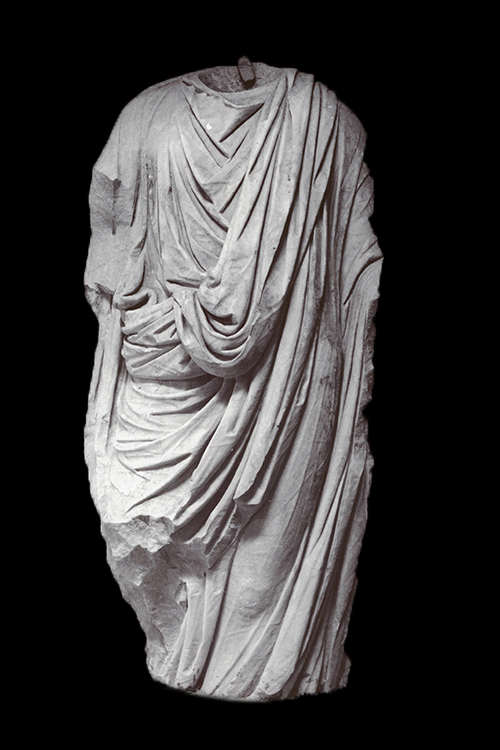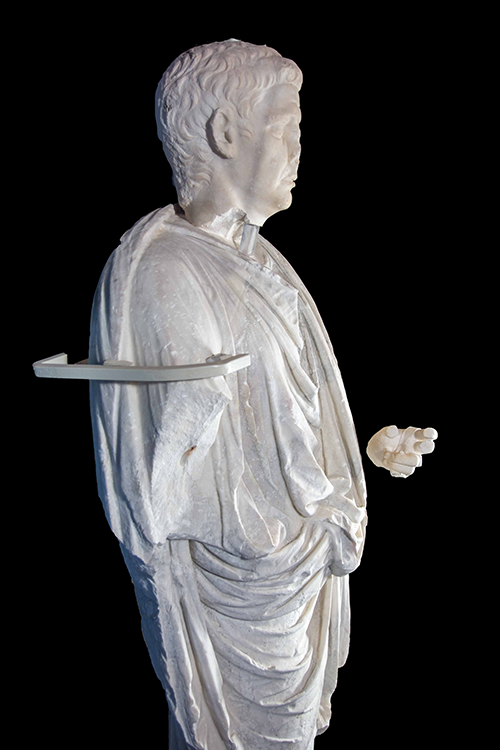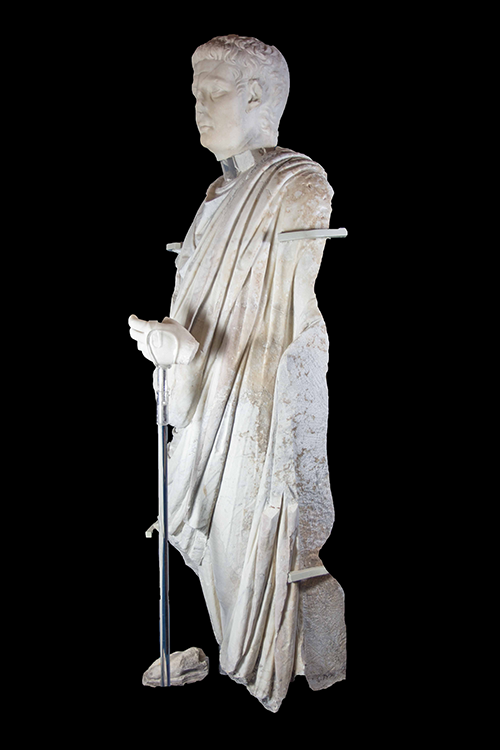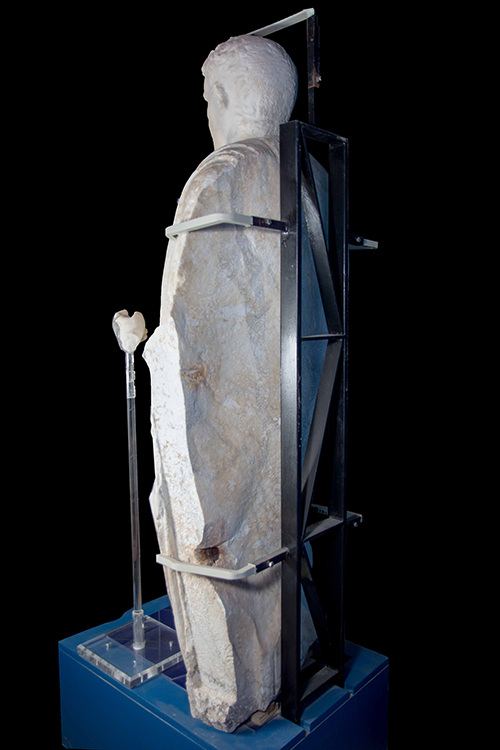Larger-than-life-size Statue (almost certainly Claudius)
Category
Domus Romana GroupAbout This Artefact
I.D. no: 28974
Dimensions: Max. H. 168 cm; Max. W. 78 cm
Material: Very fine grain white marble with very thick and obvious grey veins. Probably Carrara (possibly Pentelic, but should be more white); purple patches on toga resulting from minerals, already present in marble, oxidizing as a result of humidity.[1]
Provenance: The 1922 excavation of the Roman Domus in Rabat, Malta, “a few yards from the northern wall of the Roman Villa Museum”.[2]
Current location: Domvs Romana Museum in Rabat, Malta.
Condition: The larger-than-life-size statue has a hollow between the shoulders, clearly intended to receive the separately carved portrait head. Missing are the base together with the whole lower end of the torso from the shins downwards, though another large chip has extended the break up to the right knee. The left profile shows a rather wide vertical strip (up to 15 cm wide and 107 cm long) with a flat stippled surface (probably scored by the claw chisel) starting from the left forearm down to c. 10 cm above the bottom break. Clearly this part of the drapery, together with the forearm was carved separately and attached to this flat surface and held in place by means of a thick iron dowel, almost 3 cm in diameter, at knee level. Possibly another dowel was at hip level where very faint traces of rust are still visible. By far the largest break is at the back, which deprives the statue of the whole length of the drapery from the left shoulder down to the left shin. It is possible that it was caused by the expansion of the rusting dowels. There are no traces of use of wedges for breaking. Another iron dowel must have also held in place a separately worked right forearm and covering drapery. It was deep enough to cause another, but smaller, rough break in that area. The surviving part of the back of the statue is mostly flat but partially carved. There is no hint left of a capsa behind either of the feet.
Description: The larger-than-life-size statue was destined for a Roman dressed in a sleeved tunic covered over from the left shoulder and the right waist by the heavier toga. The weight of the body is taken by the left leg, while the right leg is slightly flexed at the knee in the act of taking a step forward. The missing right arm must have been extended forward; also raised was the left forearm to support the flowing toga from the left shoulder. The toga is worn in the standard manner of the late Republic and Early Empire, with an ample sinus which reaches down almost to the right knee and with a full-bodied balteus and umbo.
Although the head was intended to receive a separately carved head of a prominent personality, as indicated by its size and the cavity between the shoulders, the torso betrays the qualities of a work produced in series, especially in the flat treatment of the back and the fixing of additional marble parts. In spite of this, the modelling is of a high quality with an eye for detail in the treatment of the minor folds of the drapery. The pose is natural and relaxed. The forms of the left leg are made to transpire through the drapery, while the heavier folds are soft modelled with a moderate chiaroscuro effect. The use of the drill is hardly perceptible except of closer scrutiny.
Calculations of the measurements of this statue and those of the portrait head of Claudius, also larger than life-size, found in the grounds of the same Roman town house in 1881 (this catalogue, I.D. no: 28974), have proved beyond reasonable doubt that the two pieces belonged together.[3]
Discussion: For the shape of the toga one can compare this statue to those from Veleia, now in Parma,[4] which all archaeologists, from Poulsen[5] to Monaco,[6] have placed chronologically in the years between Augustus and Claudius, with the exception of Curtius who considered them Flavian.[7] Closer still to our to our statue, because they lack the repetitive linearism in the folds of the Veleia specimens, are six togate statues from the theatre of Leptis Magna dated to the reigns of Tiberius and Claudius.[8] As Saletti remarks,[9] it is during the reign of Claudius that the knee is much better modelled in spite of the covering sinus, the chest takes shape beneath the creases of the tunic, the shape of the supporting leg becomes visible through the wide channel that opens up between the thick curvilinear folds of the toga. Such a development started to be perceptible even in Caligula’s time, as his togate statue in Virginia shows,[10] and becomes even more pronounced in the Flavian togate statuary, as is clearly illustrated by the statue of Emperor Titus in the Vatican.[11] Only a confirmation of the association of the Rabat statue with the head of Claudius from the same provenance would, however, provide a secure terminus ante quem.
This is an excellent piece of Roman draped statuary that manages to create a pleasant play of light and shade by contrasting the surfaces of the toga that adhere to the body, bringing out their powerful forms, with those modelled into frequent and voluminous folds. The accurate rendering even of the details is evident in the minute and shallow creases all over the drapery, especially on the left thigh.
Bibliography: (previous publications of item):
Zammit 1922: 25: “11-9-22. N of the Roman Villa, about 30’ from the outer wall. marble statue of a male person with toga. 6’ long”. More or less the same information repeated in: Zammit 1923: 225, fig. 6. Zammit 1924: 7. Zammit 1930: 30: “very probably the figure of one of the Emperors”. Reinach 1930: 142, no. 7. Bonanno 1971: 171- 74. Bonanno 1992: 22-23, pl. 27. Bonanno 1997. Bonanno 2005: 221-22.
1 L. Lazzarini (personal communication 24/02/2004).
[2] Zammit 1924: 7.
[3] Bonanno 1992: 22; Bonanno 1997; 2005: 221. The head of Claudius has, since then, been mounted on this statue in the current display of the Domvs Romana Museum.
[4] Saletti 1968: 37-49, nos 5, 6, 9, 10, pls. 15, 19, 27, 31. For a general study of representations of the Roman toga see Goette 1991.
[5] Poulsen 1928: 53-54, figs 126-27.
[6] Monaco 1949: 11.
[7] Curtius 1932: 246, 251-57.
[8] Caputo and Traversari 1976 : 105-08, nos 84-88, pls 90-92.
[9] Saletti 1968: 51.
[10] Jucker 1973: no. 139.
[11] Daltrop et al. 1966: 23,29, 93, pls 11, 22c.




